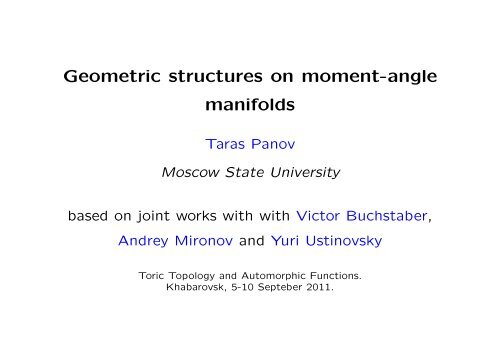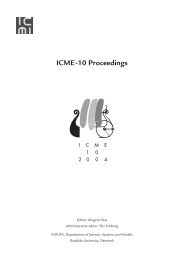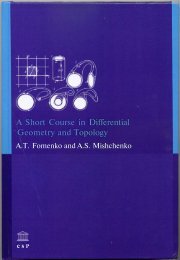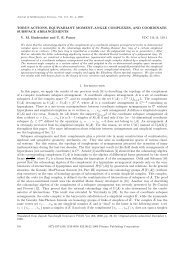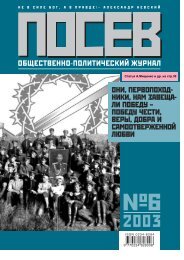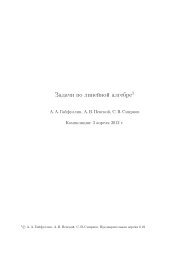pdf-slides - Geometry and Topology (Russian)
pdf-slides - Geometry and Topology (Russian)
pdf-slides - Geometry and Topology (Russian)
Create successful ePaper yourself
Turn your PDF publications into a flip-book with our unique Google optimized e-Paper software.
Geometric structures on moment-angle<br />
manifolds<br />
Taras Panov<br />
Moscow State University<br />
based on joint works with with Victor Buchstaber,<br />
Andrey Mironov <strong>and</strong> Yuri Ustinovsky<br />
Toric <strong>Topology</strong> <strong>and</strong> Automorphic Functions.<br />
Khabarovsk, 5-10 Septeber 2011.
<strong>Topology</strong> of moment-angle manifolds <strong>and</strong> complexes<br />
(joint with Victor Buchstaber).<br />
A convex polyhedron in R n obtained by intersecting m halfspaces:<br />
Define an affine map<br />
P = { x ∈ R n : ⟨a i , x⟩ + b i 0 for i = 1, . . . , m } .<br />
i P : R n → R m , i P (x) = ( ⟨a 1 , x⟩ + b 1 , . . . , ⟨a m , x⟩ + b m<br />
)<br />
.<br />
If P has a vertex, then i P is monomorphic, <strong>and</strong> i P (P ) is the intersection<br />
of an n-plane with R m = {y = (y 1, . . . , y m ): y i 0}.<br />
Define the space Z P from the diagram<br />
Z P<br />
⏐<br />
↓<br />
i Z<br />
−→ C m (z 1 , . . . , z m )<br />
⏐<br />
↓ µ<br />
⏐ ⏐⏐↓<br />
P<br />
i P<br />
−→ R m (|z 1 | 2 , . . . , |z m | 2 )<br />
Z P has a T m -action, Z P /T m = P , <strong>and</strong> i Z is a T m -equivariant inclusion.<br />
2
Proposition 1. If P is a simple polytope (more generally, if the presentation<br />
of P by inequalities is generic), then Z P is a smooth manifold<br />
of dimension m + n.<br />
Proof. Write i P (R n ) by m − n linear equations in (y 1 , . . . , y m ) ∈ R m .<br />
Replace y k by |z k | 2 to obtain a presentation of Z P by quadrics.<br />
Z P : polytopal moment-angle manifold corresponding to P .<br />
Similarly, by considering the projection µ: R m → R m instead of<br />
µ: C m → R m we obtain the real moment-angle manifold R P ⊂ R m .<br />
Example 1. P = {(x 1 , x 2 ) ∈ R 2 : x 1 0, x 2 0, −γ 1 x 1 −γ 2 x 2 +1 0},<br />
γ 1 , γ 2 > 0 (a 2-simplex). Then<br />
Z P = {(z 1 , z 2 , z 3 ) ∈ C 3 : γ 1 |z 1 | 2 + γ 2 |z 2 | 2 + |z 3 | 2 ) = 1} (a 5-sphere),<br />
R P = {(u 1 , u 2 , u 3 ) ∈ R 3 : γ 1 |u 1 | 2 + γ 2 |u 2 | 2 + |u 3 | 2 ) = 1} (a 2-sphere).<br />
3
K an (abstract) simplicial complex on the set [m] = {1, . . . , m}.<br />
I = {i 1 , . . . , i k } ∈ K a simplex. Always assume ∅ ∈ K.<br />
Consider the unit polydisc in C m ,<br />
Given I ⊂ [m], set<br />
D m = { (z 1 , . . . , z m ) ∈ C m : |z i | 1, i = 1, . . . , m } .<br />
B I := { (z 1 , . . . , z m ) ∈ D m : |z j | = 1 for j /∈ I } ∼ =<br />
∏<br />
The moment-angle complex<br />
i∈I<br />
D 2 × ∏ i/∈I<br />
Z K := ∪<br />
B I = ∪ ∏<br />
D<br />
I∈K I∈K( 2 × ∏ )<br />
S 1 ⊂ D m<br />
i∈I i/∈I<br />
It is invariant under the coordinatewise action of the torus T m .<br />
Example 2. K = 2 points, then Z K = D 2 × S 1 ∪ S 1 × D 2 ∼ = S 3 .<br />
K = ∆, then Z K = (D 2 ×D 2 ×S 1 )∪(D 2 ×S 1 ×D 2 )∪(S 1 ×D 2 ×D 2 ) ∼ = S 5 .<br />
S 1 .<br />
4
More generally, let X a space, <strong>and</strong> A ⊂ X. Given I ⊂ [m], set<br />
(X, A) I = { (x 1 , . . . , x m ) ∈<br />
m∏<br />
i=1<br />
X : x j ∈ A for j /∈ I } ∼ =<br />
∏<br />
The K-polyhedral product of (X, A) is<br />
Z K (X, A) = ∪<br />
(X, A) I ⊂ X m .<br />
I∈K<br />
i∈I<br />
X × ∏ i/∈I<br />
Another important example is the complement of the coordinate subspace<br />
arrangement corresponding to K:<br />
U(K) = C m \<br />
namely,<br />
where C × = C \ {0}.<br />
∪<br />
{i 1 ,...,i k }/∈K<br />
{z ∈ C m : z i1 = . . . = z ik = 0},<br />
U(K) = Z K (C, C × ),<br />
A.<br />
Theorem 1.<br />
Z K ⊂ U(K) is a T m -deformation retract of U(K).<br />
5
Theorem 2. If P is a simple polytope, K P = ∂(P ∗ ) (the dual triangulation),<br />
then Z KP<br />
∼ = ZP (T m -equivariantly homeomorphic).<br />
In particular, Z KP<br />
is a manifold. More generally,<br />
Proposition 2. Assume |K| ∼ = S n−1 (a sphere triangulation with m<br />
vertices). Then Z K is a closed manifold of dimension m + n.<br />
6
The face ring (the Stanley–Reisner ring) of K is<br />
Z[K] = Z[v 1 , . . . , v m ] /( v i1· · · v ik : {i 1 , . . . , i k } /∈ K ) , deg v i = 2.<br />
Theorem 3. There is an isomorphism of (bi)graded algebras<br />
H ∗ (Z K ; Z)<br />
= ∼ Tor ∗,∗ (Z[K], Z)<br />
Z[v 1 ,...,v m ]<br />
=<br />
∼ H [ Λ[u 1 , . . . , u m ] ⊗ Z[K]; d ] ,<br />
where du i = v i , dv i = 0 for 1 i m. In particular,<br />
H p (Z K ) ∼ =<br />
∑<br />
−i+2j=p<br />
Tor −i,2j<br />
Z[v 1 ,...,v m ] (Z[K], Z). 7
Corollary 1. H k (Z K ) ∼ = ⊕<br />
I⊂[m]<br />
˜H k−|I|−1 (K I ),<br />
where K I is the restriction of K to the subset I ⊂ {1, . . . , m}.<br />
If K = K P , then can rewrite the above in terms of P instead of K:<br />
Corollary 2. H k (Z P ) ∼ =<br />
⊕<br />
I⊂[m]<br />
˜H k−|I|−1 (P I ),<br />
where P I is the union of facets F i of P with i ∈ I.<br />
Remark 1. Integral version of Theorem 3 was proved independently<br />
by [Baskakov–Buchstaber–P] <strong>and</strong> [Franz].<br />
2. The product in H ∗ (Z K ) given by Theorem 3 can be also described<br />
in terms of full subcomplexes K I of Corollary 1 [Baskakov].<br />
3. There is the stable decomposition ΣZ K ≃ ∨ I⊂[m] Σ|I|+2 |K I | behind<br />
the isomorphism of Corollary 1 [Bahri–Bendersky–Cohen–Gitler].<br />
8
Geometric structures I. Lagrangian submanifolds.<br />
(joint with Andrey Mironov).<br />
(M, ω) a symplectic Riemannian 2n-manifold.<br />
An immersion i: N M of an n-manifold N is Lagrangian if i ∗ (ω) = 0.<br />
If i is an embedding, then i(N) is a Lagrangian submanifold of M.<br />
A vector field ξ on M is Hamiltonian if the 1-form ω( · , ξ) is exact.<br />
A Lagrangian immersion i: N M is Hamiltonian minimal<br />
(H-minimal) if the variations of the volume of i(N) along all Hamiltonian<br />
vector fields with compact support are zero, i.e.<br />
d<br />
dt vol(i t(N)) ∣ = 0, t=0<br />
where i 0 (N) = i(N), i t (N) is a Hamiltonian deformation of i(N), <strong>and</strong><br />
vol(i t (N)) is the volume of the deformed part of i t (N).<br />
∣<br />
9
Recall: P a simple polytope<br />
P = { x ∈ R n : ⟨a i , x⟩ + b i 0 for i = 1, . . . , m } .<br />
The polytopal moment-angle manifold Z P ,<br />
Z P<br />
⏐<br />
↓<br />
i Z<br />
−→ C m (z 1 , . . . , z m )<br />
⏐<br />
↓ µ<br />
⏐ ⏐⏐↓<br />
P<br />
i P<br />
−→ R m (|z 1 | 2 , . . . , |z m | 2 )<br />
can be written as the intersection of m − n real quadrics,<br />
Z P =<br />
{<br />
z = (z 1 , . . . , z m ) ∈ C m :<br />
m∑<br />
k=1<br />
γ jk |z k | 2 = c j ,<br />
}<br />
for 1 j m − n .<br />
10
Also have the real moment-angle manifold,<br />
{<br />
R P = u = (u 1 , . . . , u m ) ∈ R m m∑<br />
: γ jk u 2 k = c j,<br />
k=1<br />
Set γ k = (γ 1k , . . . , γ m−n,k ) ∈ R m−n for 1 k m.<br />
}<br />
for 1 j m − n .<br />
Assume that the polytope P is rational. Then have two lattices:<br />
Λ = Z⟨a 1 , . . . , a m ⟩ ⊂ R n <strong>and</strong> L = Z⟨γ 1 , . . . , γ m ⟩ ⊂ R m−n .<br />
Consider the (m − n)-torus<br />
T P = {( e 2πi⟨γ1,φ⟩ , . . . , e 2πi⟨γ m,φ⟩ ) ∈ T m} ,<br />
i.e. T P = R m−n /L ∗ , <strong>and</strong> set<br />
D P = 1 2 L∗ /L ∗ = ∼ (Z/2) m−n .<br />
Proposition 3. The (m − n)-torus T P acts on Z P almost freely.<br />
11
Consider the map<br />
f : R P × T P −→ C m ,<br />
(u, φ) ↦→ u · φ = (u 1 e 2πi⟨γ1,φ⟩ , . . . , u m e 2πi⟨γm,φ⟩ ).<br />
Note f(R P × T P ) ⊂ Z P is the set of T P -orbits through R P ⊂ C m .<br />
Have an m-dimensional manifold<br />
N P = R P × DP T P .<br />
Lemma 1. f : R P × T P → C m induces an immersion j : N P C m .<br />
Theorem 4 (Mironov). The immersion i Γ : N Γ C m is H-minimal<br />
Lagrangian.<br />
When it is an embedding?<br />
12
A simple rational polytope P is Delzant if for any vertex v ∈ P the<br />
set of vectors a i1 , . . . , a in normal to the facets meeting at v forms a<br />
basis of the lattice Λ = Z⟨a 1 , . . . , a m ⟩:<br />
Z⟨a 1 , . . . , a m ⟩ = Z⟨a i1 , . . . , a in ⟩ for any v = F i1 ∩ · · · ∩ F in .<br />
Theorem 5. The following conditions are equivalent:<br />
1) j : N P → C m is an embedding of an H-minimal Lagrangian submanifold;<br />
2) the (m − n)-torus T P acts on Z P freely.<br />
3) P is a Delzant polytope.<br />
Explicit constructions of families of Delzant polytopes are known in<br />
toric geometry <strong>and</strong> topology:<br />
- simplices <strong>and</strong> cubes in all dimensions;<br />
- products <strong>and</strong> face cuts;<br />
- associahedra (Stasheff ptopes), permutahedra, <strong>and</strong> generalisations.<br />
13
Example 3 (one quadric). Let P = ∆ m−1 (a simplex), i.e. m − n = 1<br />
<strong>and</strong> R ∆ m−1 is given by a single quadric<br />
with γ i > 0, i.e. R ∆ m−1 ∼ = S m−1 . Then<br />
N ∼ = S m−1 × Z/2 S 1 ∼ =<br />
⎧<br />
⎨<br />
⎩<br />
γ 1 u 2 1 + · · · + γ mu 2 m = c (1)<br />
S m−1 × S 1 if τ preserves the orient. of S m−1 ,<br />
K m if τ reverses the orient. of S m−1 ,<br />
where τ is the involution <strong>and</strong> K m is an m-dimensional Klein bottle.<br />
Proposition 4. We obtain an H-minimal Lagrangian embedding of<br />
N ∆ m−1 ∼ = S n−1 × Z/2 S 1 in C m if <strong>and</strong> only if γ 1 = · · · = γ m in (1). The<br />
topological type of N ∆ m−1 = N(m) depends only on the parity of m:<br />
N(m) = ∼ S m−1 × S 1<br />
N(m) = ∼ K m<br />
if m is even,<br />
if m is odd.<br />
The Klein bottle K m with even m does not admit Lagrangian embeddings<br />
in C m [Nemirovsky, Shevchishin].<br />
14
Example 4 (two quadrics).<br />
Theorem 6. Let m − n = 2, i.e. P ≃ ∆ p−1 × ∆ q−1 .<br />
(a) R P is diffeomorphic to R(p, q) ∼ = S p−1 × S q−1 given by<br />
u 2 1 + . . . + u2 k + u2 k+1 + · · · + u2 p = 1,<br />
u 2 1 + . . . + u2 k +u 2 p+1 + · · · + u2 m = 2,<br />
where p + q = m, 0 < p < m <strong>and</strong> 0 k p.<br />
(b) If N P → C m is an embedding, then N P is diffeomorphic to<br />
N k (p, q) = R(p, q) × Z/2×Z/2 (S 1 × S 1 ),<br />
where the two involutions act on R(p, q) by<br />
ψ 1 : (u 1 , . . . , u m ) ↦→ (−u 1 , . . . , −u k , −u k+1 , . . . , −u p , u p+1 , . . . , u m ),<br />
ψ 2 : (u 1 , . . . , u m ) ↦→ (−u 1 , . . . , −u k , u k+1 , . . . , u p , −u p+1 , . . . , −u m ).<br />
(2)<br />
There is a fibration N k (p, q) → S q−1 × Z/2 S 1 = N(q) with fibre N(p)<br />
(the manifold from the previous example), which is trivial for k = 0.<br />
15
Example 5 (three quadrics).<br />
In the case m − n = 3 the topology of compact manifolds R P <strong>and</strong><br />
Z P was fully described by [Lopez de Medrano]. Each manifold is<br />
diffeomorphic to a product of three spheres, or to a connected sum<br />
of products of spheres, with two spheres in each product.<br />
The simplest P with m − n = 3 is a (Delzant) pentagon, e.g.<br />
P = { (x 1 , x 2 ) ∈ R 2 : x 1 0, x 2 0, −x 1 +2 0, −x 2 +2 0, −x 1 −x 2 +3 0 } .<br />
In this case R P is an oriented surface of genus 5, <strong>and</strong> Z P is diffeomorphic<br />
to a connected sum of 5 copies of S 3 × S 4 .<br />
Get an H-minimal Lagrangian submanifold N P ⊂ C 5 which is the total<br />
space of a bundle over T 3 with fibre a surface of genus 5.<br />
16
Proposition 5. Let P be an m-gon. Then R P is an orientable surface<br />
S g of genus g = 1 + 2 m−3 (m − 4).<br />
Get an H-minimal Lagrangian submanifold N P ⊂ C m which is the<br />
total space of a bundle over T m−2 with fibre S g . It is an aspherical<br />
manifold (for m 4) whose fundamental group enters into the short<br />
exact sequence<br />
1 −→ π 1 (S g ) −→ π 1 (N) −→ Z m−2 −→ 1.<br />
For n > 2 <strong>and</strong> m − n > 3 the topology of R P <strong>and</strong> Z P is even more<br />
complicated.<br />
17
Geometric structures II. Non-Kähler complex structures.<br />
(joint with Yuri Ustinovskiy).<br />
Recall: if K = K P is the dual triangulation of a simple convex polytope<br />
P , then Z P = Z KP has a canonical smooth structure (e.g. as a<br />
nondegenerate intersection of Hermitian quadrics in C m ).<br />
Let K be a sphere triangulation, i.e. |K| ∼ = S n−1 .<br />
A realisation |K| ⊂ R n is starshaped if there is a point x /∈ |K| such<br />
that any ray from x intersects |K| in exactly one point.<br />
A convex triangulation K P is starshaped, but not vice versa!<br />
K has a starshaped realisation if <strong>and</strong> only if it is the underlying complexes<br />
of a complete simplicial fan Σ.<br />
Also recall U(K) = C m \ ∪ {i 1 ,...,i k }/∈K {z ∈ Cm : z i1 = . . . = z ik = 0}.<br />
18
Let a 1 , . . . , a m ∈ R n be the generators of the 1-dimensional cones<br />
of Σ. Consider the linear map<br />
Λ R : R m → R n , e i ↦→ a i ,<br />
where e 1 , . . . , e m is the st<strong>and</strong>ard basis of R m . Define<br />
R Σ := exp(Ker Λ R ) = { (y 1 , . . . , y m ) ∈ R m > :<br />
m ∏<br />
i=1<br />
y ⟨a i,u⟩<br />
i<br />
= 1 for all u ∈ R n} ,<br />
R Σ ⊂ R m > acts on U(K Σ) ⊂ C m by coordinatewise multiplications.<br />
Theorem 7. Let K be the underlying complex of a complete simplicial<br />
fan Σ. Then<br />
(a) R Σ acts on U(K) freely <strong>and</strong> properly, so the quotient U(K)/R Σ<br />
has a canonical structure of a smooth (m + n)-manifold;<br />
(b) U(K)/R Σ is T m -equivariantly homeomorphic to Z K .<br />
Therefore, Z K can be smoothed canonically.<br />
19
Assume m − n is even <strong>and</strong> set l = m−n<br />
2 .<br />
Choose a linear map Ψ: C l → C m satisfying the two conditions:<br />
(a) Re ◦Ψ: C l → R m is a monomorphism.<br />
(b) Λ R ◦ Re ◦Ψ = 0.<br />
Now set<br />
C Ψ,Σ = exp Ψ(C l ) = {( e ⟨ψ 1,w ⟩ , . . . , e ⟨ψ m,w ⟩ ) ∈ (C × ) m} .<br />
Then C Ψ,Σ<br />
∼ = C l is a complex-analytic (but not algebraic) subgroup<br />
of (C × ) m . It acts on U(K) by holomorphic transformations.<br />
Theorem 8. Let K be as before. Then<br />
(a) C Ψ,Σ acts on U(K) freely <strong>and</strong> properly, so the quotient U(K)/C Ψ,Σ<br />
is a compact complex manifold of complex dimension m − l;<br />
(b) there is a T m -equivariant diffeomorphism U(K)/C Ψ,Σ<br />
∼ = ZK defining<br />
a complex structure on Z K in which T m acts holomorphically.<br />
20
Theorem 9. Let K be the underlying complex of a complete rational<br />
regular simplicial fan. Let k be the number of ghost vertices in K.<br />
Then the Hodge numbers h p,q = h p,q (Z K ) satisfy<br />
(a) ( k−l<br />
p<br />
(b) h 0,q = ( l<br />
q<br />
)<br />
h p,0 ( )<br />
[k/2] for p 0;<br />
(c) h 1,q = (l − k) ( l<br />
q−1<br />
p<br />
)<br />
for q 0;<br />
)<br />
+ h<br />
1,0 ( )<br />
l+1 for q 1;<br />
q<br />
(d) l(3l+1)<br />
2<br />
− h 2 (K) − lk + (l + 1)h 2,0 h 2,1 l(3l+1)<br />
2<br />
− lk + (l + 1)h 2,0 .<br />
At most one ghost vertex is required to make dim Z K = m + n even.<br />
Note that k 1 implies h p,0 (Z K ) = 0, so that Z K does not have<br />
holomorphic forms of any degree in this case.<br />
If m = k = 2l, then Z K is a torus, <strong>and</strong> h 1,0 (Z K ) = h 0,1 (Z K ) = l.<br />
Otherwise Theorem 9 implies that h 1,0 (Z K ) < h 0,1 (Z K ), <strong>and</strong> therefore<br />
Z K is not Kähler.<br />
21
[1] В. М. Бухштабер, Т. Е. Панов. Действия тора в топологии и<br />
комбинаторике. Москва, изд-во МЦНМО, 2004.<br />
[2] Andrey Mironov <strong>and</strong> Taras Panov. Intersections of quadrics,<br />
moment-angle manifolds, <strong>and</strong> Hamiltonian-minimal Lagrangian<br />
embeddings. Preprint (2011); arXiv:1103.4970.<br />
[3] Taras Panov. Moment-angle manifolds <strong>and</strong> complexes. Trends<br />
in Mathematics - New Series. Information Center for Mathematical<br />
Sciences, KAIST. Vol. 12 (2010), no. 1, pp. 43–69;<br />
arXiv:1008.5047.<br />
[4] Taras Panov <strong>and</strong> Yuri Ustinovsky. Complex-analytic structures on<br />
moment-angle manifolds. Moscow Math. J. (2011), to appear<br />
(2010); arXiv:1008.4764.<br />
22


